Once, I woke up stiff, my muscles tight from hours of sitting. Even simple tasks like tying my shoes were hard. I learned that flexibility exercises are essential for everyone. They help us move freely, feel stronger, and prevent injuries.
Imagine bending down to pick up something without pain. Or reaching for something high without effort. Exercises to improve flexibility make us more mobile. They boost our confidence and energy, helping us stay agile and resilient.
Flexibility workouts aren’t about being a contortionist. They’re about small steps to feeling better. This guide offers easy methods, from dynamic stretches to yoga poses. Let’s start moving better, together.
Key Takeaways
- Flexibility improves daily movements and reduces stiffness.
- Flexibility exercises are accessible for all fitness levels and ages.
- Regular practice prevents injuries and enhances athletic performance.
- Simple routines can fit into any lifestyle, from home workouts to gym sessions.
- Increased flexibility boosts confidence and overall well-being.
Understanding Flexibility and Its Benefits
Flexibility lets your body move joints and muscles fully. Flexibility training and mobility exercises help improve this. They make daily movements easier. Let’s explore its science and why it matters.
What Is Flexibility?
There are three types of flexibility:
- Dynamic: Uses movement-based stretches, like leg swings.
- Static: Holds stretches, such as touching toes.
- Functional: Prepares muscles for everyday actions, like bending to pick up objects.
Benefits of Improved Flexibility
Regular mobility exercises loosen muscles and improve posture. Better flexibility also lowers injury risk during workouts or daily tasks. Athletes perform better in sports needing agility.
For seniors, it helps with balance and keeps them independent.
How Flexibility Affects Physical Activity
Limited flexibility limits movement efficiency. For instance, tight hamstrings can affect running form. Flexibility training ensures muscles work well, preventing injuries and boosting energy use.
Small improvements in range of motion lead to smoother, safer movements. This is true for activities like yoga or weight lifting.
Warm-Up Exercises to Increase Flexibility
Before starting stretches, warming up is crucial. Dynamic stretching and flexibility drills are essential. Skipping this step can lead to injuries. But, a good warm-up increases blood flow and gets muscles ready.
⏳ Get Your Energy Back with Discount!
“A 2023 study by the American Council on Exercise found that dynamic movements cut muscle strain by 40% during workouts.”
Importance of Warming Up
Begin with 5-10 minutes of light cardio, like jogging in place. This gets your heart rate up and warms your muscles. Cold muscles are stiff and more prone to injury.
Warming up also improves joint mobility and focus. It prepares your body for deeper stretches.
Dynamic Stretches You Can Try
Try these dynamic stretching moves after your cardio:
- Leg Swings: Hold a wall, swing one leg forward and back 10 times per side. Focus on controlled swings, not forced motion.
- Arm Circles: Extend arms sideways, make 10 large circles forward and backward. Rotate shoulders smoothly, not abruptly.
- Hip Rotations: Stand with feet hip-width, twist torso slowly 15 times. Engage core for balance.
- Walking Lunges: Lunge forward with each step, lowering hips until both knees bend 90 degrees. Keep core tight and knees aligned.
Do each move for 30 seconds to 1 minute. Gradually increase the range as your muscles warm up. Remember, these are fluid motions, not holds.
Static Stretching for Greater Flexibility
Static stretching is key for improving flexibility. It involves holding a stretch to lengthen muscles, enhancing mobility. It’s great after workouts or in dedicated sessions, making it safe for improving range of motion.
“Static stretches are foundational for long-term flexibility gains when done correctly.”
What Is Static Stretching?
This method isolates muscles by holding a stretch for 15–30 seconds. It’s different from dynamic movements because it focuses on sustained tension. Studies show it reduces muscle stiffness and boosts performance when done right. Always warm up first to avoid injury.
Common Static Stretching Techniques
- Hamstring Stretch: Sit with legs straight, reach toward toes, hold 20–30 seconds.
- Quadriceps Stretch: Stand, bend one knee, grasp ankle, pull heel toward glutes, hold 15 seconds per side.
- Chest Opener: Stand by a doorframe, arms at 90 degrees, lean forward to feel the stretch in the chest.
Avoid bouncing, which can strain muscles. Breathe deeply and focus on smooth transitions. Consistency is key—try 2–3 sessions weekly for noticeable progress.
Yoga Poses to Enhance Flexibility
Yoga helps improve your flexibility in a holistic way. It builds core strength and increases breath awareness. By adding foundational poses to your routine, you can loosen tight muscles and increase your range of motion safely.
Key Yoga Poses for Flexibility
Here are three poses that really work:
- Downward-Facing Dog: Stretches your calves, hamstrings, and shoulders. Keep your hands shoulder-width apart and heels grounded.
- Pigeon Pose: Opens your hips and glutes. Lower your forearms if full extension feels challenging.
- Cobra Pose: Improves spinal flexibility. Engage your lower back while lifting your chest.
“Yoga teaches us to breathe through discomfort, which helps sustain stretches longer,” says yoga instructor Sarah Lee, a certified flexibility coach with 10+ years of experience.
Incorporating Yoga into Your Routine
Start with 10–15 minutes daily using these steps:
- Pair poses with deep breathing exercises.
- Alternate yoga sessions with other flexibility workouts like dynamic stretching.
- Use props—blocks or straps—to modify poses if needed.
Even brief practice can boost mobility. Try yoga first thing in the morning or as a cooldown after cardio to maximize flexibility gains.
Foam Rolling for Muscle Release
Foam rolling is a way to release muscle tension. It helps with mobility exercises and flexibility training. It loosens muscle knots, improving how far you can move. Do it before or after working out for best results.
“Consistent foam rolling improves tissue elasticity and circulation.”—Sports Medicine Journal
How Foam Rolling Works
Start with light pressure to avoid hurting your muscles. The roller works on the fascia, the layer of tissue that can get tight. Focus on sore spots for 30-60 seconds each.
Techniques for Effective Foam Rolling
| Body Part | Technique | Tips |
|---|---|---|
| IT Band | Side-lying roll along outer thigh | Use slow, controlled movements |
| Quadriceps | Lie face down, roll front of thigh | Pause on sore spots |
| Hamstrings | Sit with roller under thighs, hinge at hips | Avoid lower back strain |
| Calves | Seated, roll under lower legs | Use body weight for pressure |
| Upper Back | Lie on back, place roller under upper back | Keep core engaged |
| Hip Flexors | Kneel on roller, hips over knees | Roll from hip to knee |
| Lower Back | Arch back over roller | Maintain core engagement |
Choose the right roller for your needs. Grid rollers are for tight muscles, textured rollers for sensitive areas, and basic foam rollers for beginners.
- Grid rollers: Deep tissue relief
- Textured rollers: Gentle pressure
- Basic foam rollers: Ideal for all skill levels
- Avoid rapid rolling—aim for 1-2 minutes per area
- Never roll directly on bones
- Breathe deeply during sessions
Combine foam rolling with dynamic stretches for the best results. Being consistent is key to improving flexibility over time.
Incorporating Resistance Training for Flexibility
Resistance training is not just for building muscle. It can also improve your flexibility. Exercises like squats and presses help by making movements more controlled. This method works well with exercises to improve flexibility and flexibility drills.
“Strength and mobility go hand in hand when trained smart.” – Dr. Emily Carter, Exercise Physiologist
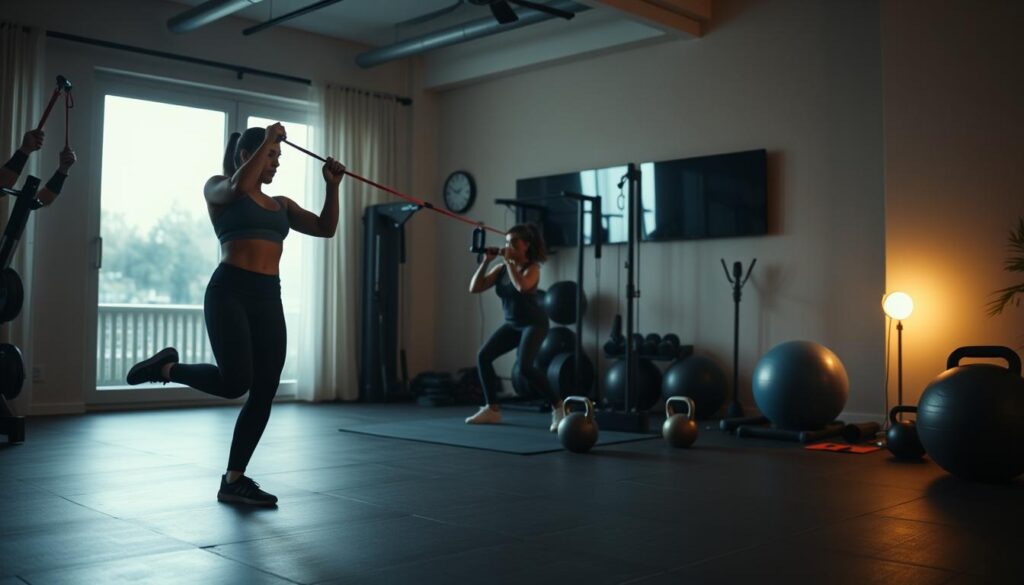
Benefits of Resistance Training
Resistance training strengthens muscles and tendons. It also increases joint mobility. Moves like Romanian deadlifts and overhead presses help muscles lengthen under load. This promotes balanced flexibility.
Eccentric phases, or lowering weights slowly, build neuromuscular control. This reduces stiffness over time.
Key Resistance Exercises
- Deep squats with toes turned out to open hips
- Romanian deadlifts to target hamstrings and glutes
- Overhead presses to improve shoulder mobility
- Loaded stretches like paused lunges to combine strength and mobility
Do slow eccentric reps—lower weights twice as long as you lift—to boost flexibility. Add these exercises 2-3 times a week. Mix in bodyweight drills like cat-cow stretches for full-body mobility. Consistent practice will change how your body moves.
Flexibility Exercises for Beginners
Starting a stretch routines journey? Focus on consistency, not perfection. Even 10 minutes daily can build foundational flexibility. Here’s how to begin safely and stay motivated.
Simple Stretching Routines
Begin with these bodyweight-friendly moves. Repeat each stretch 2–3 times, holding for 15–30 seconds:
- Hamstring Stretch: Sit on the floor, legs straight. Reach toward toes, keeping back straight.
- Cat-Cow Stretch: On hands and knees, arch and round your spine in fluid motions.
- Child’s Pose: Kneel on the floor, sit back toward heels, and extend arms forward.
Tips for Maintaining Consistency
Turn stretching into a habit with these strategies:
- Pair sessions with existing routines (e.g., after morning coffee).
- Set phone reminders at the same time daily.
- Track progress in a notebook or app like FlexibilityLog.
“Consistency beats intensity for beginners. Focus on showing up,” says Dr. Lena Torres, a sports physiotherapist.
Expect gradual progress—noticeable improvements may take 4–6 weeks. Slight tension is normal, but sharp pain means stop. Celebrate small wins, like touching your toes an inch further each week.
Flexibility Exercises for Athletes
I create flexibility programs for athletes that fit their sport’s needs. Tailoring stretches to your movement patterns can lower injury risk and enhance performance.
Specific Stretches for Different Sports
Targeted routines address sport-specific imbalances. For example:
| Sport | Key Areas | Stretches |
|---|---|---|
| Running | Hip mobility | Pigeon pose, hip flexor stretches |
| Swimming | Shoulder flexibility | Doorway chest stretches |
| Martial Arts | Hamstring flexibility | Seated forward bends |
“Sport-specific stretches reduce overuse injuries by 22%, per a 2023 study in Sports Medicine.”
Recovery and Flexibility Techniques
Recovery phase integration is key. Here’s how to balance flexibility with training:
- Incorporate PNF stretching twice weekly for advanced gains
- Pair static stretches with post-workout cooldowns
- Use dynamic movements during active recovery days
Periodize flexibility training into your cycles. For instance, add 10 minutes of PNF stretching on deload weeks to maintain gains. Track progress with weekly sit-and-reach tests.
Core Exercises for Better Flexibility
Adding core-focused workouts to your routine can change how you move. A strong core isn’t just about abs. It also includes muscles like the lower back and pelvic floor. Strengthening these areas helps you stretch safely and move better.
Mobility exercises that target the core help you stretch right. This reduces the chance of getting hurt.
Why Core Strength Matters
- Core stability prevents overcompensation during stretches, protecting joints.
- Strong core muscles enhance balance, making advanced mobility exercises safer.
- A stable midsection allows deeper stretches without straining limbs.
Core Stretching Exercises to Try
Try these moves that blend strength and flexibility:
- Plank with rotation: Hold a plank then rotate hips side-to-side to engage obliques.
- Supine leg extensions: Lie on your back and lift legs while keeping core engaged.
- Cat-cow stretch: Flow through this yoga pose to mobilize spine and core muscles.
- Rotational stretches: Sit tall and twist torso slowly to stretch obliques.
- Abdominal extensions: Lie on stomach and gently arch back to stretch front abs.
By focusing on core strength in your workouts, you’ll get stronger and more flexible. These exercises help you move better and improve your overall fitness.
Flexibility Exercises for Seniors
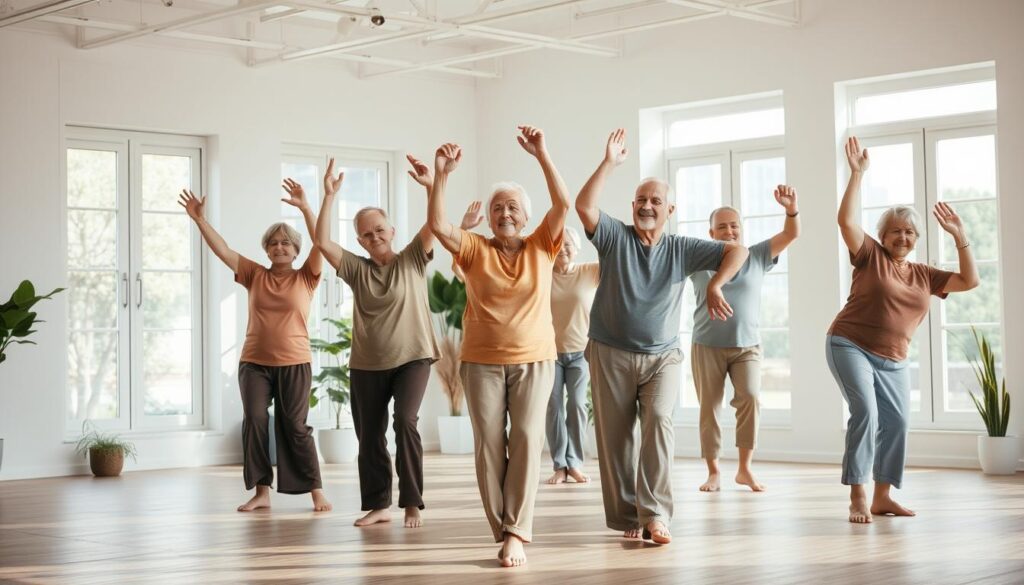
I’ve seen how important flexibility exercises are for seniors. They help stay mobile. Gentle stretches improve balance and lower fall risks, making everyday tasks simpler.
Importance of Flexibility in Aging
As we get older, our joints stiffen and muscles shorten. Regular flexibility exercises help fight these changes. They keep us independent and comfortable. Even simple stretches can increase mobility and reduce joint pain.
Safe Stretching Tips for Older Adults
- Use chairs or walls for support during stretches.
- Avoid sudden movements; prioritize slow, controlled motions.
- Hold stretches 15-30 seconds—never push through pain.
I suggest starting with seated calf stretches or shoulder rolls. These gentle stretches build up over time. For those with arthritis, it’s wise to get advice from a physical therapist to make sure movements are safe.
Remember:Consistency is key, not how hard you stretch. Even 5-10 minutes a day can help. Focus on exercises that feel right and stop if you feel any pain.
Tracking Your Progress in Flexibility
Measuring your flexibility journey turns vague goals into clear milestones. Whether you’re mastering flexibility drills or flexibility training routines, tracking ensures you stay on course. Here’s how to quantify your improvements:
Setting Flexibility Goals
Start by defining goals that matter. Functional goals like “touch my toes” or measurable targets like “increase hamstring stretch by 2 inches” work best. Use the sit-and-reach test or shoulder mobility checks weekly to spot trends. Pro tip: Pair goals with a flexibility drill schedule for faster results.
Tools and Apps to Measure Flexibility
Track progress with these methods:
- Home tests: Use a yardstick for sit-and-reach or smartphone apps like FlexTrack to log measurements
- Apps: Fitbod and Yoga Studio include flexibility progress dashboards
- Wearables: Devices like WHOOP track mobility metrics during workouts
| Tracking Method | How It Works |
|---|---|
| Photo Journals | Take weekly photos of stretches to visually compare progress |
| Range-of-Motion Charts | Record measurements for hips, hamstrings, and shoulders in a spreadsheet |
| App Dashboards | Automated progress graphs via fitness apps |
Adjust your routine based on data. If hip mobility stalls, add more dynamic stretches. Celebrate small wins—they fuel long-term consistency.
Conclusion: Embrace a Flexible Lifestyle
I’ve shown how yoga and dynamic stretching improve flexibility for the long term. To keep up the good work, remember to drink water and get enough rest.
Final Tips for Staying Flexible
Drink water every day and try to sleep 7–8 hours to fix your body. Do yoga for flexibility two times a week to keep your joints healthy. Before you exercise, do some dynamic stretching to get your muscles ready.
Change your routine as you get stronger. Try new poses or make your exercises harder over time.
Encouragement for Your Flexibility Journey
It’s okay to face challenges, but every little bit helps. Just 3 minutes of stretching a day can make a big difference. Keep track of your progress in a journal to see how far you’ve come.
Your journey is special, so focus on your own goals, not what others do. Begin with a simple stretch like a seated forward bend from yoga. Every step you take makes your body stronger.
FAQ
What are some effective exercises to improve flexibility?
How often should I practice flexibility workouts?
Can mobility exercises help improve flexibility?
What is the difference between dynamic stretching and static stretching?
How can I safely perform flexibility drills at home?
What specific flexibility exercises are good for seniors?
Are there any flexibility workouts suitable for athletes?
Did you like this article? See also: https://powerfitguide.com/how-to-improve-your-posture-with-exercise-tips-and-workouts/

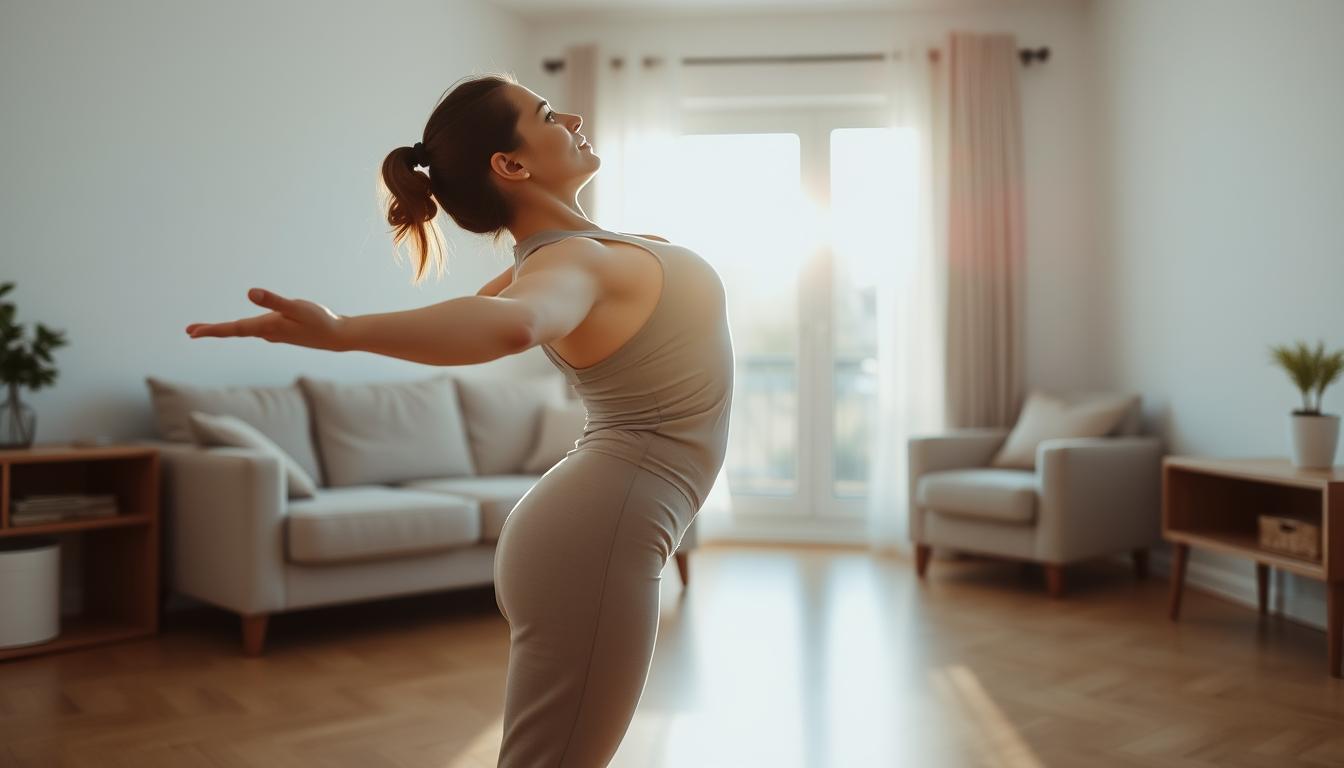
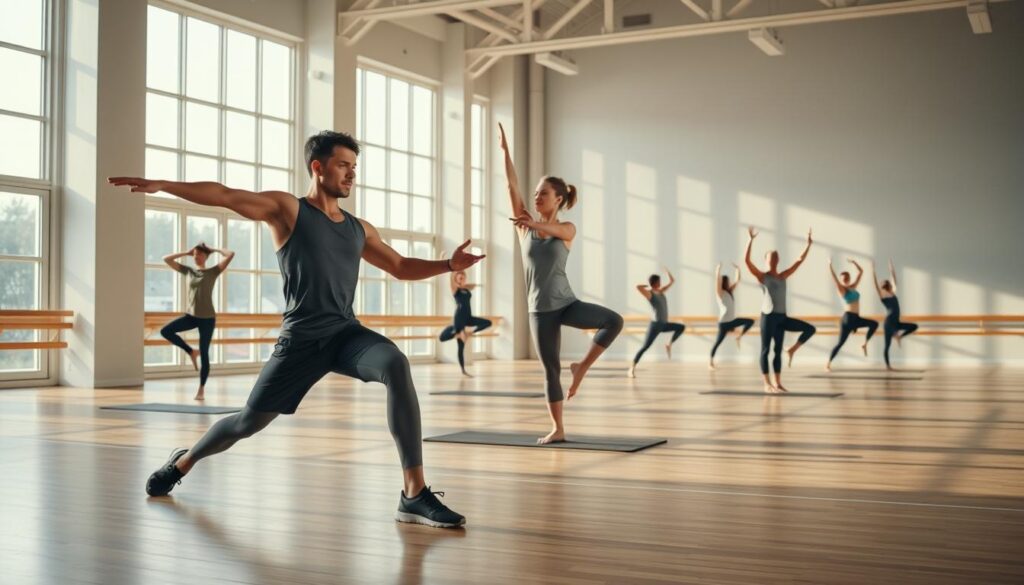
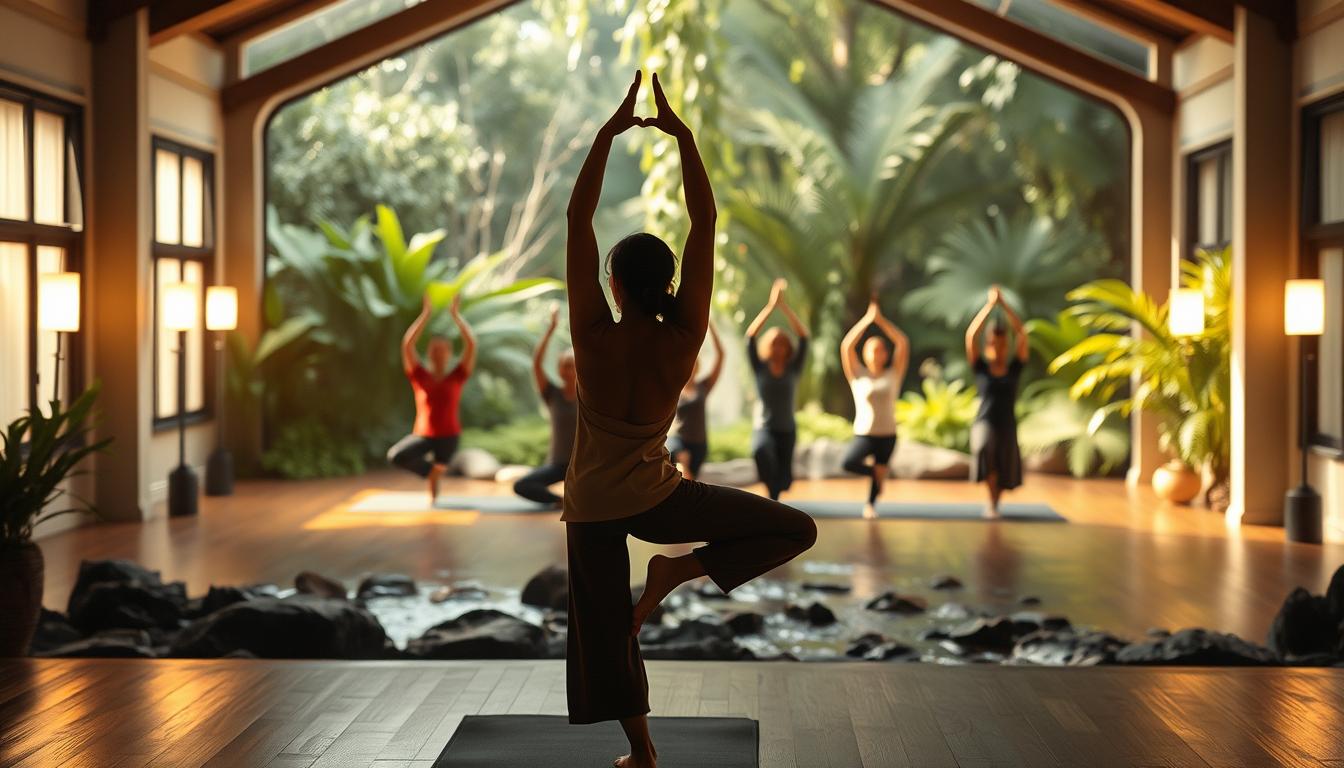

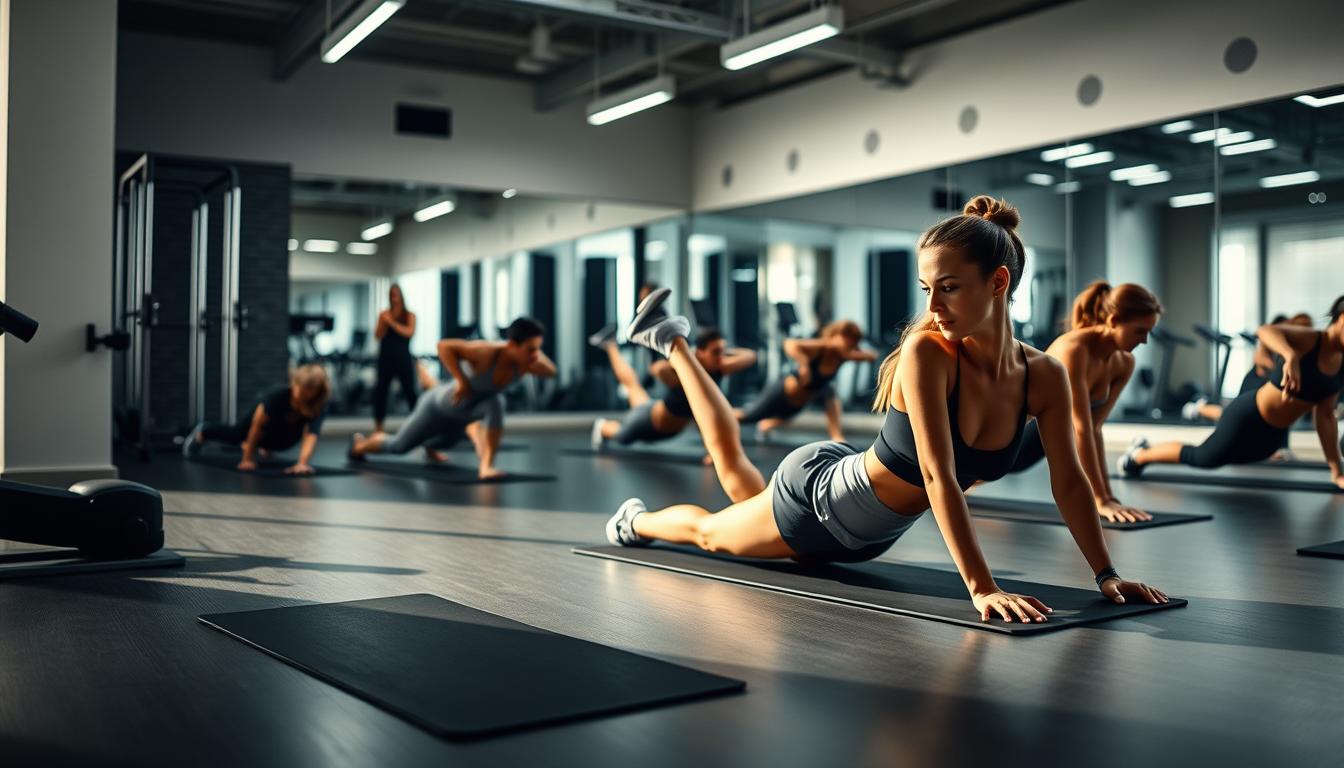

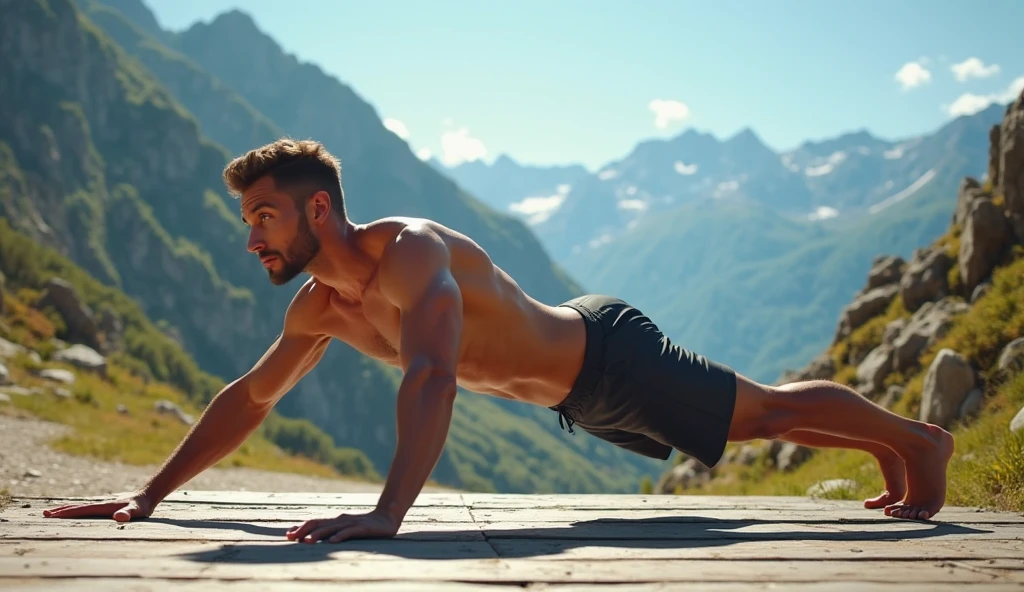
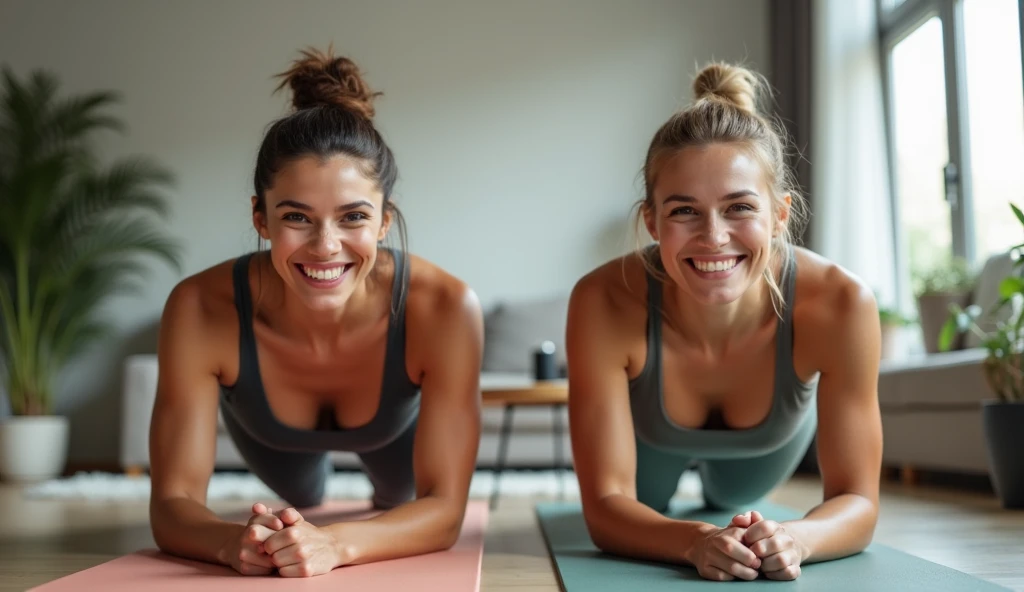
Comment on “Boost Your Flexibility with These Exercises”